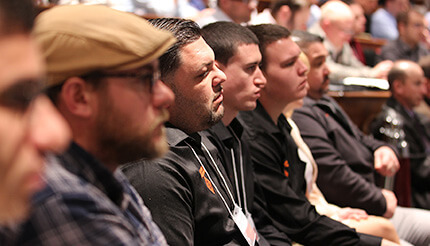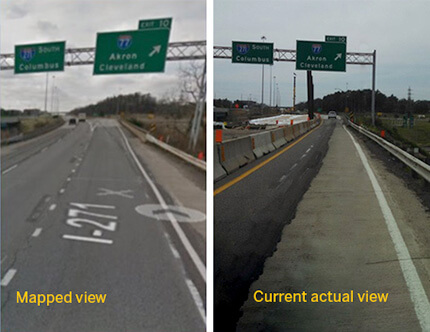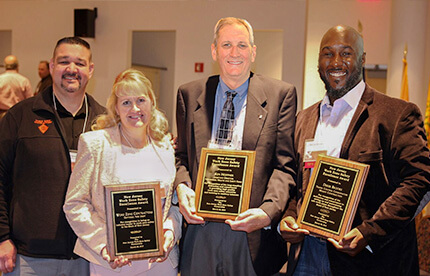Roadway work crews face many dangers: inattentive drivers, hazardous dust, night work, and soon, autonomous vehicles
Cosponsors CAIT and the New Jersey Work Zone Safety Partnership welcomed more than 250 people to the annual New Jersey Work Zone Safety Conference on March 29. In a lead up to National Work Zone Awareness Week (April 3–7 this year), the New Jersey conference drew industry professionals from construction, engineering, utilities, public safety and law enforcement, and public works, maintenance, and operations.
The day kicked off with remarks from FHWA-New Jersey Division Administrator Robert Clark; OSHA Regional Director Robert Kulick; and NJDOT Commissioner Rick Hammer. All three men reemphasized the importance for drivers to slow down, stay alert, and not fall prey to electronic devices or other attention-diverting stimuli when driving through a work zone, and they urged everyone to be responsible for their own safety and the safety of others. “Both workers and drivers need to be acutely aware of their surroundings if we’re going to reach the goal of zero deaths in work zones,” said Commissioner Hammer.
OSHA silica standards were discussed at the 2016 conference, but this year’s audience heard about the dangers of crystalline silica on a distinctly more personal level from Edward Mallon. Crystalline silica is a colorless, odorless fine dust resulting from cutting or disturbing concrete and other materials containing silica. Mallon is a retired sandhog from Local 147, who developed silicosis after years on the job. He shared a moving account of his experience and how the deadly disease has impacted his life.
Kenneth Hoffner, assistant director for New Jersey’s Laborers Health and Safety Fund (NJLHSF), then thoroughly explained OSHA Table 1, which lists 18 silica-generating tasks along with specific mandates and measures to reduce hazardous exposure to crystalline silica. If contractors and workers follow these recommendations, they hopefully will avoid the devastating effects that Mallon and all those with silicosis suffer daily.
In a related presentation, Mike Corbett, an OSHA compliance assistance specialist, covered the most common OSHA violations in the construction industry.
The keynote speaker, Ross Sheckler, a managing partner of iCone Products and Calmar Research, presented “Smart Work Zones, Connected Work Zones, Automated Vehicles–Putting the Pieces Together.” Sheckler addressed the advent of autonomous vehicles, noting what was once thought to be far in the future is going to be reality much sooner than people originally thought. One challenge intelligent transportation systems must overcome is safely navigating work zones, which are often put in place or removed quickly due to weather changes or shifting priorities. This transitory and weather-dependent nature makes these areas very difficult to map.
Following the keynote, the Work Zone Safety Excellence Awards were presented. These are awarded to individuals or companies to publicly recognize outstanding leadership, expertise, judgment, communication, and other skills that contribute to a safe environment for roadway workers. This year’s winners were: Work Zone Contractors (Deptford, NJ); Derek Brooks from Local 472 (currently working for Mount Construction, Berlin, NJ); and one of the morning presenters, Ken Hoffner from NJLHSF.
In the afternoon, Ed Sitler, civil engineering department manager for AECOM in Piscataway and a P.E. with more than 30 years in the industry, shared his experience designing and managing the Route 139 Pulaski Contract 2 project.
Next, CAIT project manager Ted Green, PE, talked about mobile work zones and showed excellent visuals on proper setup and implementation in keeping with MUTCD specifications.
The day ended with a panel discussion about benefits and risks of nighttime work zones led by John Mazur, safety specialist and emergency response coordinator for OSHA. The panel included representatives from the local police, New Jersey State Police, NJDOT, and a traffic safety contractor and two traffic control coordinators. Extensive discussion on the pros and cons of working after dark was spurred by the audience’s questions and contributions.
April 2017




